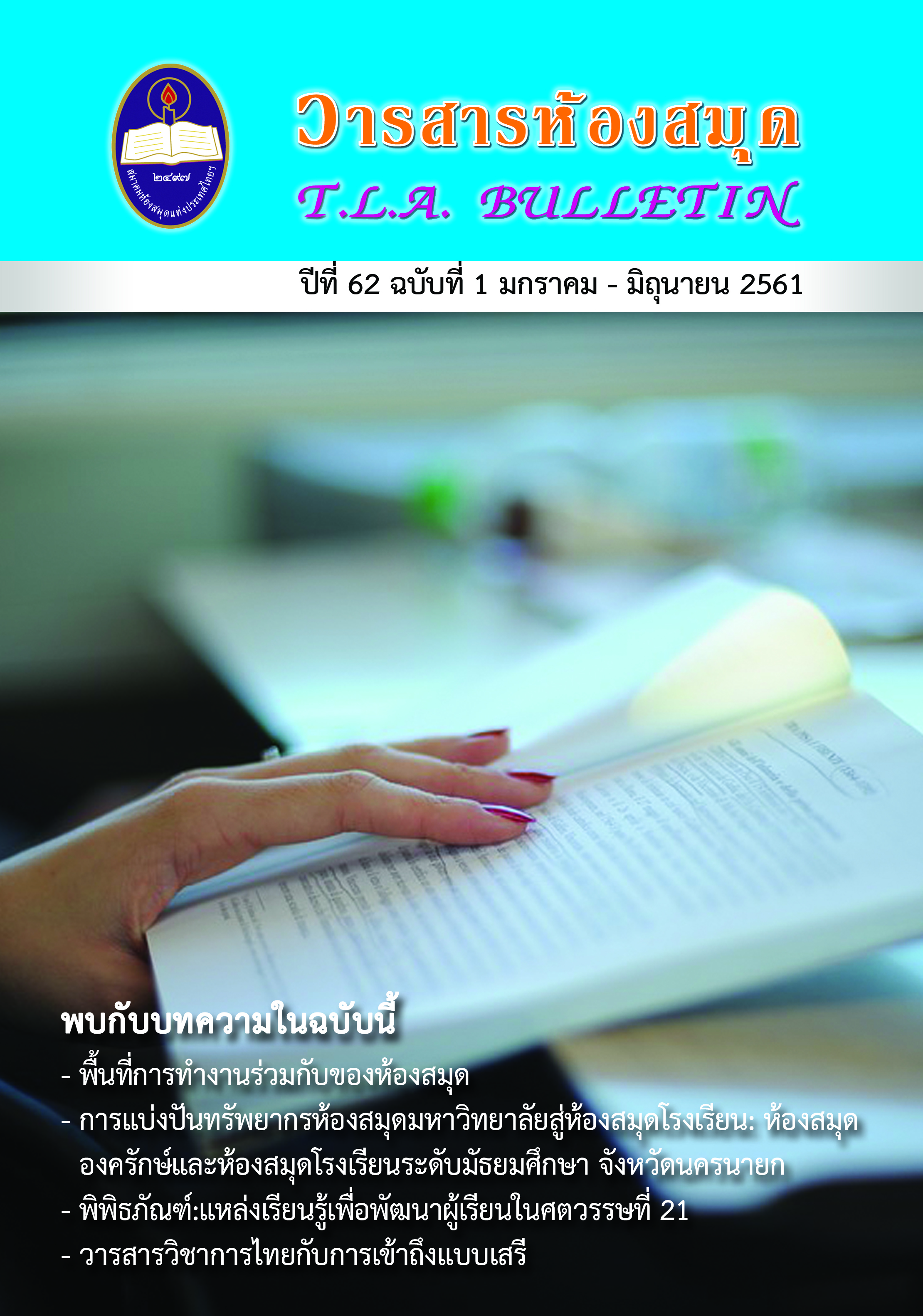พิพิธภัณฑ์: แหล่งเรียนรู้เพื่อพัฒนาผู้เรียนในศตวรรษที่ 21
คำสำคัญ:
พิพิธภัณฑ์, ศตวรรษที่ 21, ผู้เรียนบทคัดย่อ
พิพิธภัณฑ์เป็นแหล่งการเรียนรู้ที่มีคุณค่าและสร้างสรรค์สังคมแห่งการเรียนรู้ ช่วยกระตุ้นให้เกิดการเรียนรู้ ทั้งการรู้จักตนเองและการรู้จักผู้อื่น ฝึกให้ผู้เรียนมีทักษะการคิดซึ่งเป็นทักษะที่สำคัญต่อการดำรงชีวิตในศตวรรษที่ 21 พิพิธภัณฑ์ในศตวรรษที่ 21 จะเป็นแหล่งการเรียนรู้ตลอดชีวิต ให้ข้อมูลวิชาการ เชื่อมโยงวิชาการเข้ากับการมีคุณภาพชีวิตที่ดีของสังคม และยังเป็นแหล่งท่องเที่ยวของประชาชนทุกคน ดังนั้นพิพิธภัณฑ์ในประเทศไทยควรพัฒนาด้านต่าง ๆ เพื่อเป็นแหล่งเรียนรู้สำหรับผู้เรียนในศตวรรษที่ 21ได้แก่ สถานที่การจัดแสดงและการส่งเสริมกิจกรรม การบริหารจัดการพื้นที่ ความร่วมมือการประชาสัมพันธ์ และบุคลากร บทความนี้นำเสนอความหมาย ความสำคัญ ประเภทของพิพิธภัณฑ์ และพิพิธภัณฑ์ในฐานะแหล่งเรียนรู้เพื่อพัฒนาผู้เรียนในศตวรรษที่ 21
Downloads
เอกสารอ้างอิง
Boonnoon, C. (2010). Cooperation of Libraries andMuseums of the Same Affiliation. Master Thesis. Bangkok: Chulalongkorn University. [In Thai]
Boonyakiet, C. (2010). National Museum of Singapore. Bangkok: Princess MahaChakri Sirindhorn Anthropology Centre (Public Organization). [In Thai]
Charu,T. (2008). Tourist’s Opinions towards Geo Tourism Management of Sirindhorn Museum, Amphoe Sahatsakhan Changwat Kalasin. Master Thesis. Khon Khan: Khon Khan University. [In Thai]
Chatuporn, U.(2014).The Research to Relevant Factors for the Expanding an Experience of Museum Visitors from an Applications with Social Media. Master Thesis. Bangkok: Bangkok University. [In Thai]
Chiachanphong, P. (2000). The Trend of Local Museums in Thailand. In Academic Seminar Documents in the Topic “Local Museums in Thailand.” (p.91-102). 2nd ed.Bangkok: Princess MahaChakriSirindhorn Anthropology Centre Silpakorn University. [In Thai]
Chitphilai, S. (2008). The Developing of Multimedia in Thai So Mesuem, Kusuman District, SakonNakhon Province. Master Thesis. Mahasarakham: Mahasarakham University. [In Thai]
Chumpengpan, P. (1987). Museology. PhraNakhon Si Ayutthaya Province: Chao Sam Phraya National Museum. [In Thai]
Eamthanakul,S. (2006). Guidelines for Facility Management of Local Museum in Bangkok: The Case of Sampantawong District. Master Thesis. Bangkok: Thammasat University. [In Thai]
Gaweewong, G. (2015).The Curator of Small Parts of History: The Jim Thompson Art Center. In Museum Refocused. (p.85-100). Bangkok: National Discovery Museum Institute. [In Thai]
Grek, Sotiria. (2008). In and Against the Museum: The Contested Spaces of Museum Education for Adults. Retrieved April 19, 2017, from URL: http://www.research.ed.ac.uk/portal/files/14608855/In_and_against_the_museum.pdf
ICONSIAM. (2016). ICONSIAM Heritage Museum. Retrieved April 4, 2018, from URL: http://www.iconsiam.com/en/iconsiam/pressroom/140 [In Thai]
ICOM. (2007). Museum Definition-ICOM. Retrieved June 11, 2016, from URL: http://icom.museum/who-we-are/the-vision/museum-definition.html.
Imsombat, A. (2007). A Proposed Model of Folklore Virtual Museum in the North-Eastern Region of Thailand.Master Thesis. Bangkok: Chulalongkorn University. [In Thai]
Faculty of Finearts, Chiangmai University. (2009). UNESCO Museum to Museum Partnership Project: Lampang Temples Pilot Trainningincollections Management. Retrieved April 1, 2018, from URL: http://www.finearts.cmu.ac.th/blog/2010/06/21/กิจกรรมความร่วมมือระหว-3/ [In Thai]
Jongkol, J. (1989). Museology. 2nd ed. Bangkok: The Fine Arts Department.
Kojaranont, R. (2005). Strategic Planning to Develop Bangkok National Museum.Bangkok: Office of National MuseumFine Art DepartmentMinistry of Culture. [In Thai]
Koompoka, S. (2015).Thai National Flag Museum Management. Silpakorn University Journal of Social Sciences, Humanities, and Arts 8 (2), 2750-2765. [In Thai]
Lin, Aleck,&Gregor, Shirley. (2006). Designing Websites for Learning and Enjoyment: A Study of Museum Experiences. Retrieved July 20, 2011, from URL: http://www.irrodl.org/index.php/irrodl/aticle/view/364
Marty, Paul F. (2007). Museum Website and Museum Visitors: Before and After the Museum Visit. Retrieved February 2, 2011, from URL: http://marty.ci.fsu.edu/preprints/marty mmc 2007.pdf
Mukdawijitra,K. K. (2015). Museum Refocused: Viewpoint from Museums’ Staff. In Museum Refocused. (p. 9-18). Bangkok: National Discovery Museum Institute. [In Thai]
Office of National Museum. (2005). Museum Management in Business Aspect. Bangkok: The Fine Arts Department Ministry of Culture. [In Thai]
Phahoolo, S. (2015). The Way of Curator. In Musuem Refocused. (p.103-117). Bangkok: National Discovery Museum Institute. [In Thai]
Suphavanij, P. (2015). The Onion (Main Audience) of Art Gallery: Bangkok Art and Culture Centre. In Museum Refocused. (p.119-136). Bangkok: National Discovery Museum Institute. [In Thai]
Sumettikoon, P.,& Chaiya,S. (2016). Technology and Learning Media in Leading Museums in Asia. TLA Bulletin, 60 (1), 57-80. [In Thai]
Sattayawut, R. (2007). The Guideline to Develop Museums in Thailand. Master of Term Paper. Bangkok: SuanDusit Rajabhat University. [In Thai]
Saelao,P. (2011). The Use of Learning Resources by the Fourth Level Students of The Schools under Phitsanulok Educational Service Area Office 1. Master Thesis. Nonthaburi: SukhothaiThammathirat Open University. [In Thai]
Suwansatit, S. (2007). Museum as a Lifelong Learning Centers. Institute of Culture and Arts Journal Srinakharinwirot University,8 (16),26-31. [In Thai]
Simon, N. (2007). Discourse in the Blogosphere: What Museums Can Learn from Web 2.0. Museum and Social Issues, 2 (2), 257-274.
Sudweha, U. (2005). Museum Information Presentation Using a Wireless System. Master Project. Bangkok: King Mongkut’s University of Technology North Bangkok. [In Thai]
Sungsri, S.et al. (2005). The Organizing of Learning in Lifelong Learning Resource Center : Museums : Research Report:Museum. Bangkok: Office of the Education Council. [In Thai]
Thailand Museums in New Century. (2002). Bangkok: Princess MahaChakri Sirindhorn Anthropology Centre (Public Organization). [In Thai]
Thansettakij. (2017). Development of QR-AR Code System for Using as National Museum Guide. Retrieved March15, 2018, from URL: http://www.thansettakij.com/content/167710 [In Thai]
Validom, S. (2008).Museums and Local History: The Process of Collaborative Learning. Bangkok: Lek-Prapai Viriyahpant Foundation. [In Thai]
Vimonsuntirungsri, T.,& Choemprayong,S. (2016). What the Audiences See: Behavior of Museum Visitors through Photovoice Technique. Journal of Information Science, 34 (2), 1-25. [In Thai]
Vongmonta, A. (2005). Learning Resources for Education.Rusmilae Journal, 26 (3), 32-42. [In Thai]
Wilaikum,F. (2013). The Development of a Web Site for Phitsanulok Museum with Participatory Approaches. Master Thesis. Bangkok: Srinakharinwirot University. [In Thai]
Wisudthiluck, S.,ed. (2016). MuseumPractice: Lessons from Others. 2nd ed. Bangkok: National Discovery Museum Institute. [In Thai]
Wongjirakit, T.(2012). The Promotion of Tourism Attractions in the Museum: CaseStudy of KhonKaen Hong Moon Mang.The Independent Study of Master Degree. Khon Khan: Khon Khan University. [In Thai]
Yamee, C. (2013). Museum Management:Research Center and Dinosaur Museum. KhonKaen: Department of Mineral Resources. [In Thai]




